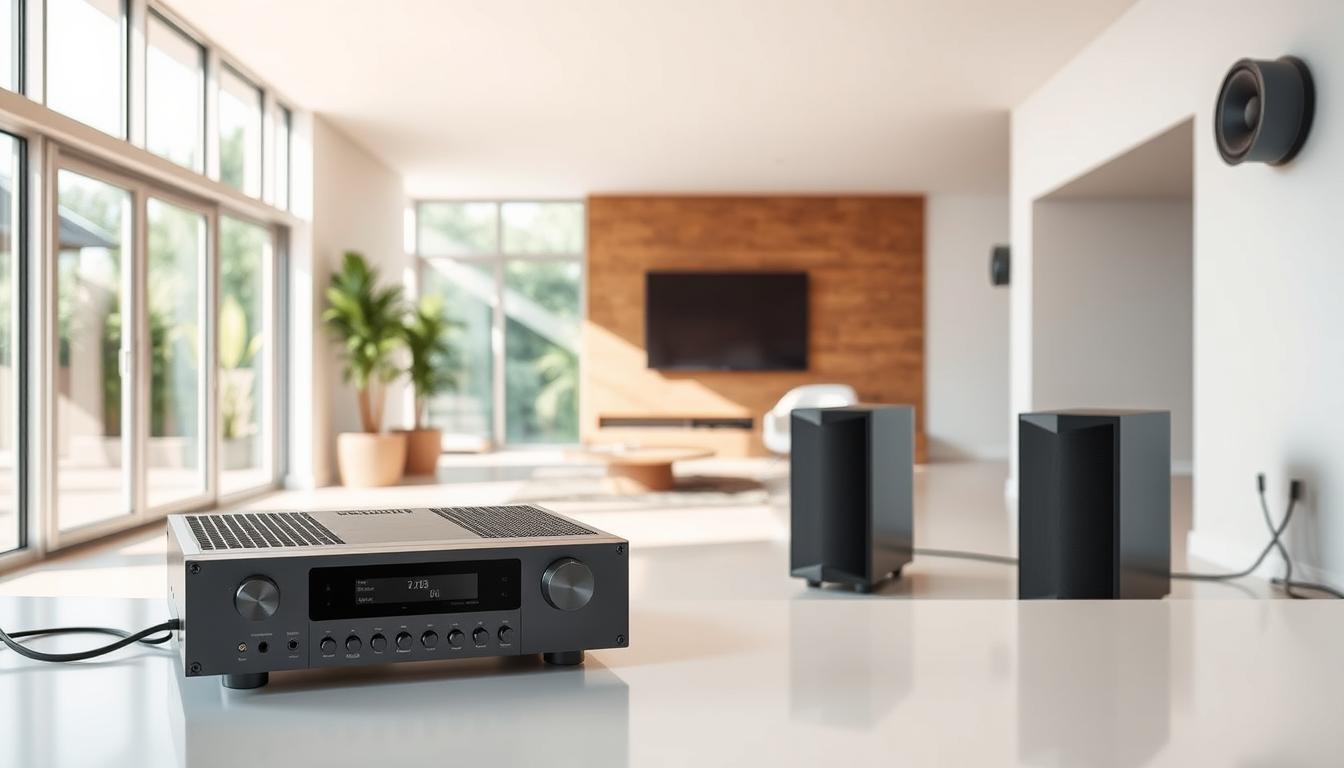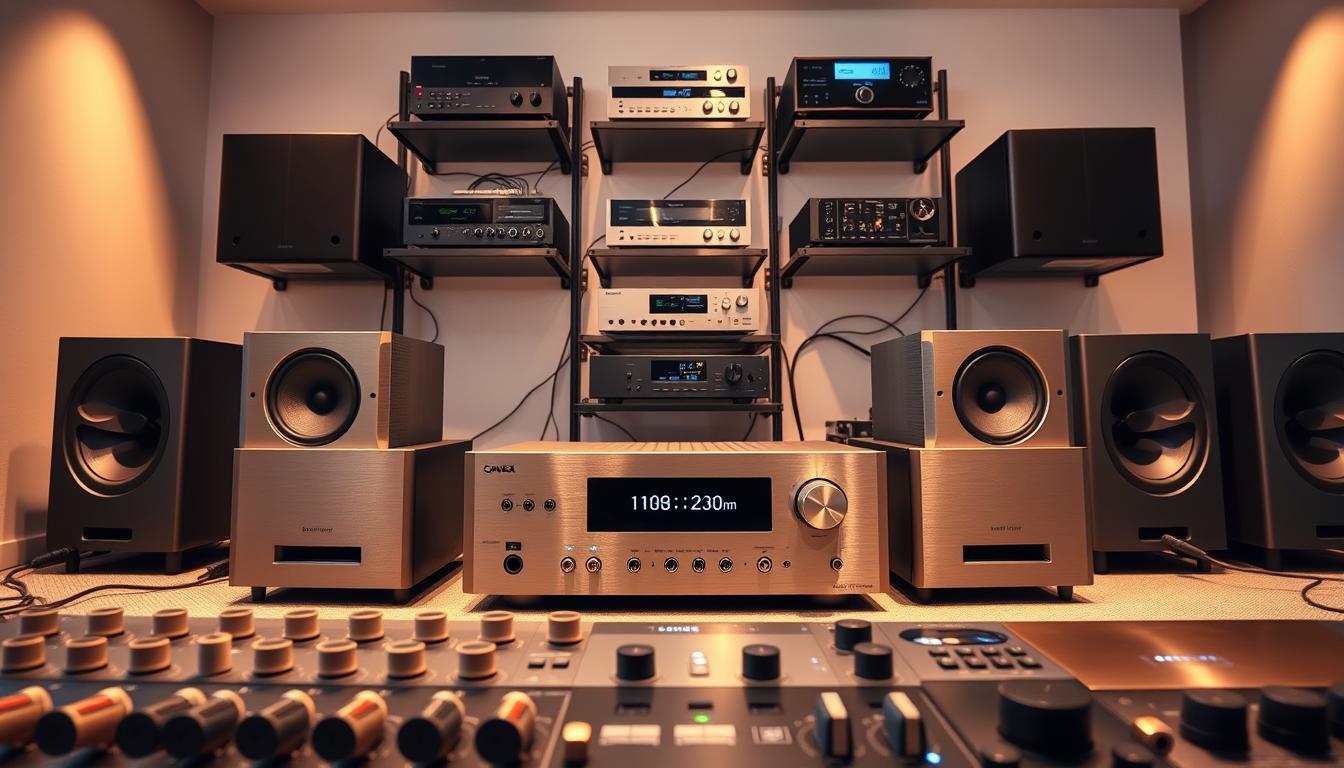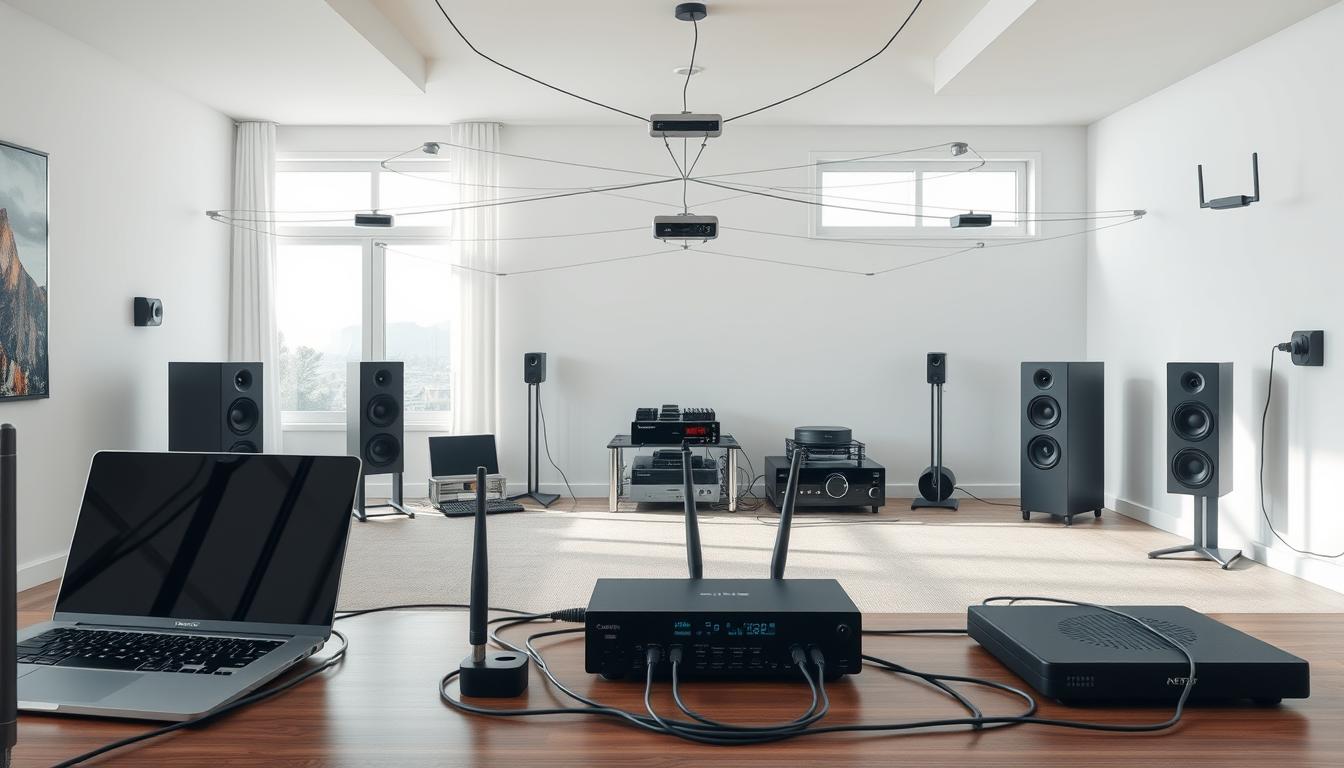Imagine moving from your living room to the kitchen without missing a beat of your favorite song. Modern whole-home audio solutions make this possible, creating immersive soundscapes that adapt to your daily routines. Whether you’re hosting friends or relaxing alone, synchronized playback across spaces ensures every corner of your house delivers crisp, uninterrupted sound.
This guide breaks down the essentials of designing a cohesive listening environment. You’ll explore practical strategies for selecting speakers, configuring zones, and optimizing sound quality. We focus on simplicity – no technical expertise required – while addressing common challenges like device compatibility and room acoustics.
Why does this matter? Homes with unified audio systems report 3x more music usage according to recent surveys. Families enjoy shared playlists during chores, while movie nights gain cinematic depth when dialogue follows you to the snack bar. The right setup turns ordinary moments into extraordinary experiences.
Key Takeaways
- Seamless music transitions between rooms enhance daily activities
- Professional-grade results require strategic speaker placement
- Synchronized playback maintains audio consistency across zones
- Multiroom systems increase property appeal and functionality
- Custom configurations adapt to various home layouts
Understanding Multi-Zone Audio Systems
Picture your home filled with music that follows you seamlessly from room to room. Multi-zone setups connect speakers across spaces, letting you control sound in individual areas or play synchronized tracks everywhere. Unlike traditional setups, these systems let you tailor audio to match activities in each zone.

Definition and Benefits
At its core, this technology links speakers through Wi-Fi, Bluetooth, or wired connections. Brands like Sonos simplify wireless setups – position speakers, power them, and sync via apps. You maintain consistent volume levels and track progress without manual adjustments.
Key advantages include:
- Uninterrupted playback during chores or workouts
- Customizable sound profiles for kitchens vs bedrooms
- Centralized control via smartphones or voice commands
Enhancing Daily Routines
Morning routines transform when playlists flow from showers to coffee stations. Dinner prep becomes lively with upbeat music in cooking zones, while adjacent areas stay quiet for homework. During gatherings, hosts adjust bass levels near dance areas without affecting conversation spaces.
Families report using their audio systems 73% more after installing multi-zone capabilities. The flexibility supports both shared moments and personal listening experiences, adapting to your home’s rhythm.
Key Components of a Multi-Zone Audio Setup
Your home’s soundtrack deserves equipment that matches its rhythm. Three core elements form the foundation: speakers for sound delivery, amplifiers for power management, and connection options that define flexibility. Choosing the right combination ensures seamless harmony between rooms.

Essential Speakers and Amplifiers
Every zone needs at least one speaker. Bookshelf models work for open spaces, while slim soundbars suit entertainment centers. For discreet setups, in-wall or ceiling speakers blend into walls. Passive speakers require external amplifiers, unlike active models with built-in power.
Amplifiers become crucial when managing multiple zones. They boost signals from your source devices and distribute audio cleanly. Multi-channel models let you control volume per room independently.
Wired vs Wireless Options
Wired systems use speaker cables connected to a central hub. They deliver consistent quality but need careful installation. Wireless setups rely on Wi-Fi or Bluetooth, offering easier placement changes.
| Feature | Wired | Wireless |
|---|---|---|
| Installation | Requires in-wall wiring | Plug-and-play setup |
| Sound Quality | Uncompressed audio | Depends on network |
| Scalability | Limited by wiring | Easy zone additions |
Hybrid systems mix both approaches. Use wired connections for home theaters and wireless speakers for flexible zones like patios. Your choice depends on existing infrastructure and desired sound precision.
Planning Your Room Layout and Network Infrastructure
A flawless whole-home listening experience starts long before equipment arrives. Strategic planning prevents dead zones and ensures your network handles simultaneous streams effortlessly. Let’s map your space for balanced sound and robust connectivity.

Optimizing Speaker Placement
Position speakers 6-8 feet apart in square rooms, angling them toward central areas. For open-concept spaces, create triangular formations to distribute sound evenly. Avoid corners—they amplify bass unnaturally.
In kitchens, mount ceiling speakers above prep zones. Bedrooms benefit from wall-mounted units near seating areas. Always test placements with a portable speaker before finalizing setup.
Setting Up WiFi and Mesh Networks
Standard routers struggle with multi-room systems. Check your network speed using free online tools—aim for at least 25 Mbps per zone. Upgrade to a mesh system if signals weaken between floors.
| Feature | Traditional WiFi | Mesh Network |
|---|---|---|
| Coverage | Single router | Multiple nodes |
| Device Handling | 15-20 devices | 50+ devices |
| Speed Consistency | Varies by distance | Uniform across zones |
Brands like Sonos use dedicated wireless channels for speakers, bypassing internet traffic. For wired multi-room audio systems, Ethernet backbones guarantee zero dropouts. Hybrid approaches work best in mixed-use homes.
How to Set Up a Multi-Zone Audio System
Your music should flow effortlessly as you move through your home. The secret lies in pairing speakers with intuitive control apps that adapt to your lifestyle. Modern systems transform smartphones into command centers, letting you orchestrate soundscapes room by room.

Choosing Your Command Hub
Control apps determine how easily you manage zones. Sonos S2 remains popular for its drag-and-drop room grouping, while Bose Music offers voice-controlled presets. Look for these features:
- Cross-platform compatibility (iOS/Android/Windows)
- Streaming service integrations like Spotify Connect
- Firmware update notifications
| App | Key Feature | Zone Limit |
|---|---|---|
| Sonos S2 | Room-filling trueplay tuning | 32 zones |
| Yamaha MusicCast | Hi-res audio support | 24 zones |
| Denon HEOS | Quick-group presets | 16 zones |
Activating Your Audio Zones
Start by connecting one speaker to your Wi-Fi through the manufacturer’s app. Power on additional units sequentially – most apps auto-detect new devices. Assign rooms using custom names like “Sunset Patio” or “Chef’s Kitchen” for quick recognition.
Group zones by holding your phone near each speaker during setup. Test synchronization by playing a drum track – delays over 50ms need network adjustments. Reduce wireless interference by positioning routers away from microwaves or baby monitors.
If Spotify skips, enable QoS settings in your router dashboard. For persistent dropouts, assign static IP addresses to your primary speakers. Most systems include diagnostic tools that pinpoint connection weak spots.
Integrating Smart Home and Voice Control Features
Say “play jazz in the kitchen” while chopping vegetables, and watch your system respond instantly. Voice commands transform how you interact with home audio, blending convenience with cutting-edge tech. Modern setups sync effortlessly with popular assistants like Google Home and Amazon Alexa, letting you manage music without lifting a finger.

Matching Platforms to Your Ecosystem
Stick to one voice assistant if you own mostly Google or Amazon devices. Sonos speakers work with both, while Apple HomePods require Siri. Check your speaker brand’s compatibility before assigning rooms.
| Platform | Multi-Room Support | Streaming Services |
|---|---|---|
| Google Home | Unlimited zones | Spotify, YouTube Music |
| Amazon Alexa | Up to 12 zones | Amazon Music, Apple Music |
| Apple AirPlay 2 | 4 simultaneous zones | Tidal, Deezer |
Configure commands through your assistant’s app. Name zones clearly: “Alexa, lower volume in the patio speakers” works better than vague requests. Group rooms for parties using phrases like “Play everywhere.”
If responses lag, check Wi-Fi signal strength near your devices. Reposition smart hubs away from metal objects or thick walls. Update firmware monthly to maintain smooth control across platforms.
Voice control shines during chores. Adjust bass levels while washing dishes or skip tracks during workouts—all through natural speech. Families appreciate separate volume settings for kids’ rooms and shared spaces.
Customizing Audio Zones for Different Rooms
Ever wish your kitchen playlist could automatically soften when you move to the patio? Tailored audio zones make this possible by adapting soundscapes to your home’s unique layout. Modern systems let you craft personalized listening environments that match daily routines and special occasions.

Creating Custom Groups and Zones
Group speakers by floor or activity through your control app. Name zones like “Sunset Lounge” or “Home Office” for instant recognition. Most apps allow temporary combinations – sync patio and pool speakers for summer gatherings with one tap.
| Group Type | Speaker Count | Activation Method |
|---|---|---|
| Floor-based | 4-8 units | Voice command |
| Activity-focused | 2-4 units | App preset |
| Temporary | Unlimited | Drag-and-drop |
Streaming Services and App Integration
Sync multiple streaming services to access all your playlists. Sonos supports 100+ platforms, while Bose prioritizes Apple Music integration. Create service-specific favorites that appear across rooms for quick access.
| App Feature | Spotify Connect | AirPlay 2 |
|---|---|---|
| Multi-room sync | Yes | Limited |
| Voice control | Alexa/Google | Siri only |
| Content merging | Playlist blending | Single service |
Adjust EQ settings per zone through manufacturer apps. Boost vocals in cooking areas while enhancing bass in entertainment spaces. These profiles save automatically, ensuring consistent sound whether streaming podcasts or classical content.
Troubleshooting Common Multi-Zone Audio Issues

Even the most advanced systems hit snags – but most glitches have straightforward fixes. We’ll tackle connectivity gremlins and app frustrations that disrupt your listening flow.
Silencing Dropouts & Delays
Spotty playback often stems from network congestion. Start by rebooting your router and moving it away from metal objects. Use apps like WiFi Analyzer to check signal strength near each speaker.
If audio stutters during peak hours:
- Assign priority to your audio system in router QoS settings
- Create a separate 5GHz band for streaming
- Swap wireless extenders for mesh nodes
Taming App Tantrums
When control apps freeze or zones disappear:
| Issue | Quick Fix |
|---|---|
| Zones not showing | Force-quit app + restart devices |
| Volume sliders unresponsive | Check firmware updates |
| Playback mismatch | Re-sync via manufacturer’s tool |
Persistent bugs? Reset speakers to factory settings through physical buttons. For Sonos units, hold the Join button for 10 seconds until the light flashes amber.
Pro tip: Bookmark your system’s diagnostic page. Most brands offer real-time network health reports showing latency spikes or bandwidth hogs.
Expert Tips and Advanced Setup Options
Elevate your listening experience beyond basic setups with professional-grade enhancements. While DIY solutions work for simple configurations, complex projects demand specialized expertise to maximize performance and aesthetics.
Professional Installation Considerations
In-wall and ceiling speakers require precise cutting and wiring. Certified technicians assess your space to determine optimal placement while avoiding structural elements. They handle:
- Concealed cable routing through walls
- Custom mounting brackets for angled ceilings
- Compliance with local building codes
| Feature | Professional Installation | DIY Approach |
|---|---|---|
| Cost | $150-$300 per zone | $0 (labor only) |
| Time Investment | 2-4 hours | 6+ hours |
| Equipment Needed | Specialized tools | Basic toolkit |
| Result Quality | Seamless integration | Visible components |
Enhancing Sound Quality with Additional Equipment
Upgrade your audio clarity using these pro-approved additions:
- Dedicated amplifiers for power-hungry towers
- Acoustic panels to reduce echo
- Subwoofers with room correction software
For critical listening spaces, try stereo pairing identical bookshelf speakers. Position them 8-10 feet apart at ear level, angled inward at 30 degrees. This creates a “sweet spot” with immersive separation.
Pro tip: Future-proof your system by choosing amplifiers with Dolby Atmos support. This ensures compatibility with next-gen spatial audio formats.
Conclusion
Transform every corner of your living space into a personalized soundstage. With strategic planning and modern technology, you achieve synchronized playback that adapts to your lifestyle. The result? Music that breathes life into daily routines while maintaining crystal-clear quality across rooms.
Centralized control through intuitive apps puts entire home audio at your fingertips. Adjust bass levels in entertainment areas or soften bedroom volumes without interrupting activities. Voice commands and smart integrations add convenience, letting you focus on experiences rather than settings.
Quality speakers and proper placement ensure balanced acoustics in kitchens, patios, and media rooms. Whether hosting gatherings or enjoying solitude, your system becomes an invisible conductor orchestrating perfect moments. Start small, expand gradually, and let sound redefine how you inhabit each space.
The journey to whole-home audio rewards patience with unmatched versatility. Embrace the harmony of technology and design – your soundtrack awaits.
FAQ
What are the main benefits of a multi-zone audio system?
A multi-zone audio system lets you play different music or content in separate rooms simultaneously. You can control each zone independently via apps like Sonos or Denon HEOS, enhancing flexibility and personalization for households with varied listening preferences.
Do I need separate amplifiers for each audio zone?
It depends on your setup. Wired systems often require multi-channel amplifiers like those from Yamaha or Onkyo. Wireless systems, such as Bose SoundTouch or Sonos, use built-in amplification in each speaker, eliminating the need for extra hardware.
Can I mix wired and wireless speakers in one system?
Yes. Brands like Denon and Sonos support hybrid setups. For example, you can connect wired outdoor speakers to an AV receiver while using wireless indoor units, all controlled through a single app for seamless integration.
How do I optimize speaker placement for balanced sound?
Position speakers at ear level in primary listening areas. Avoid corners or walls that cause bass buildup. Use ceiling speakers like those from Klipsch for even distribution in open-concept spaces, and test placements with a sound calibration app.
Which control apps work best with multi-zone systems?
Popular options include Sonos App, Denon HEOS, and Bose Music. These apps let you group zones, adjust volume per room, and stream from Spotify or Apple Music. Many also integrate with Google Home and Amazon Alexa for voice commands.
Can I use voice assistants like Alexa with multi-zone audio?
Absolutely. Systems compatible with Amazon Alexa or Google Assistant allow voice control. For example, say, “Alexa, play jazz in the living room,” to trigger music on Echo devices or linked speakers like Sonos One.
How do I stream different content to multiple zones?
Most systems let you assign unique sources to each zone. For instance, play a podcast in the kitchen via Spotify Connect while streaming a movie soundtrack in the home theater via HDMI ARC, all managed through the central app.
What causes connectivity issues in wireless multi-zone setups?
Weak WiFi signals or network congestion often disrupt playback. Fix this by upgrading to a mesh network (e.g., Google Nest Wifi) or using dedicated audio channels like SonosNet. Ensure routers and speakers are within range.
How can I improve sound quality in larger rooms?
Add subwoofers like the SVS SB-1000 for deeper bass or install acoustic panels to reduce echoes. High-end amplifiers from Marantz or Anthem also enhance clarity, especially in home theaters or spacious living areas.
Should I hire a professional installer for complex setups?
For whole-house systems with in-wall wiring or advanced configurations, professionals ensure optimal performance. Companies like Crutchfield offer design services, while brands like Lutron provide solutions for syncing lighting and audio zones.


